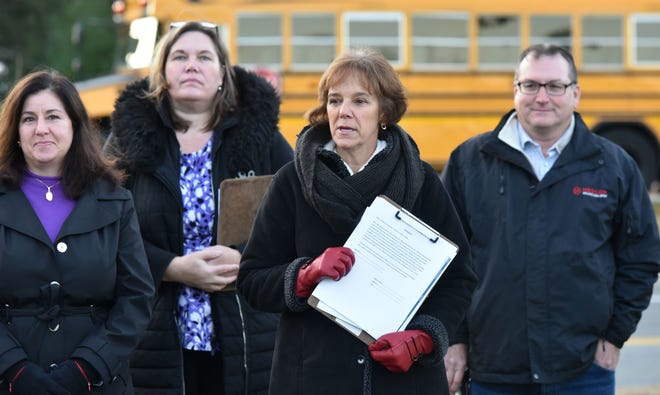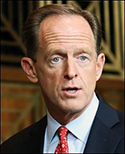
16 February 22
A Daily Struggle Against Fascism
Is what our work at RSN has become. It’s real, it’s pervasive and most people would rather not look at it.
This is a pretty serious battle against some pretty serious people.
A budget would be a big help.
Marc Ash
Founder, Reader Supported News
Sure, I'll make a donation!
If you would prefer to send a check:
Reader Supported News
PO Box 2043 / Citrus Heights, CA 95611
Follow us on facebook and twitter!

16 February 22
Live on the homepage now!
Reader Supported News
READER SUPPORTED NEWS WANTS YOU: If you never or almost never contribute we want you to join the people who do. They’re just like you. They work just as hard and are just as deserving. This is “Reader Supported News” it’s what we do. We use community support to challenge the media machine. Chip in and watch it work.
Marc Ash • Founder, Reader Supported News
Sure, I'll make a donation!
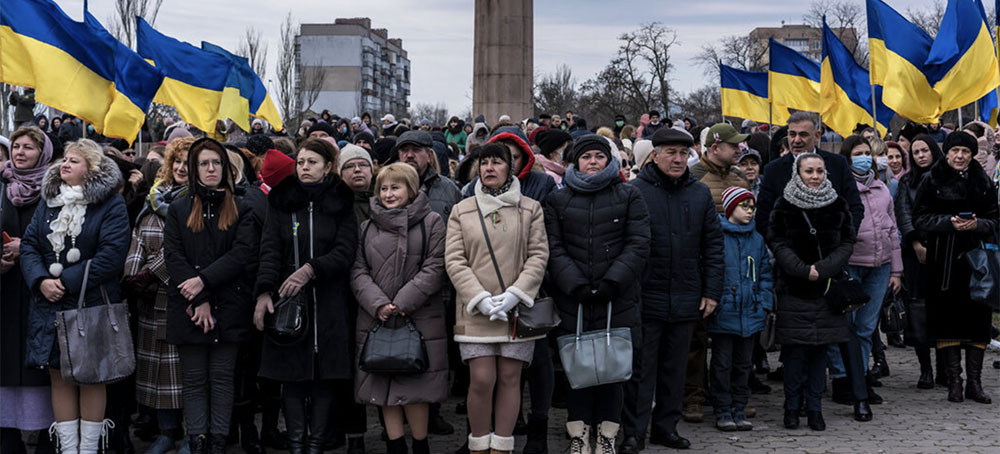
An Off-Ramp From War? Russia Says It Pulled Back Some Troops From Ukraine Border as Talks Continue
Democracy Now!
Excerpt: "Russia has announced plans to pull back some troops from the Ukrainian border in a possible effort to deescalate the standoff over Ukraine but still intends to continue with military exercises in Belarus and the Black Sea."
Russia has announced plans to pull back some troops from the Ukrainian border in a possible effort to deescalate the standoff over Ukraine but still intends to continue with military exercises in Belarus and the Black Sea. This comes as Ukrainian President Volodymyr Zelensky indicated on Monday the country may drop its bid to join NATO and the U.S. continues to urge U.S. citizens to leave Ukraine, warning a Russian invasion could come as soon as Wednesday. We speak with Medea Benjamin, co-founder of CodePink, who says the U.S. is continuing to escalate the crisis by directing U.S. funds to weapons and loans for Ukraine. “It seems the United States is more anxious for Russia to invade than Russia is to invade,” says Benjamin.
Transcript
This is a rush transcript. Copy may not be in its final form.
AMY GOODMAN: We begin today’s show looking at the crisis along the Russia-Ukraine border. Russia has announced it’s pulling back some troops from the border, in a possible effort to deescalate the standoff, but Russia is moving ahead with military exercises in Belarus and the Black Sea. On Monday, Russian television aired footage of Russian Foreign Minister Sergey Lavrov urging Russian President Vladimir Putin to continue and intensify diplomatic negotiations. Also on Monday, Ukrainian President Volodymyr Zelensky said Ukraine may drop its bid to join NATO, saying membership may have only been a dream.
The United States has reportedly been warning allies Russia could invade Ukraine as soon as Wednesday — that’s tomorrow, February 16th. Ukraine’s president responded by announcing February 16th would become a “day of unity” for Ukrainians. The United States has also urged all U.S. citizens to leave Ukraine, as well as Belarus and parts of Moldova. The State Department has also moved its remaining staff from Kyiv to a temporary site in western Ukraine in the city of Lviv due to the Russian military buildup.
To talk more about the crisis, we’re joined by Medea Benjamin, the co-founder of CodePink.
Welcome to Democracy Now!, Medea. Can you talk about the latest developments around Ukraine and Russia, and the role of the United States?
MEDEA BENJAMIN: Well, unfortunately, in the midst of this crisis, the United States is sending more weapons to Ukraine, and, as the secretary-general of the United Nations said without mentioning the United States, the incendiary rhetoric, saying that “Russia is ready to invade. Russia is ready to invade.” It seems the United States is more anxious for Russia to invade than Russia is to invade, and this is not helpful at all.
I think it’s a very positive development that Zelensky has basically recognized that Ukraine will not enter NATO, and that is a positive thing. And all of the diplomatic efforts that are going on are extremely helpful and necessary, and we hope there will be an off-ramp, because the possibility of war is just unacceptable. Our members, our friends in Congress are trying to say to the administration that they cannot go into any military conflict without first going to Congress, which is something that would back up the administration. And so, we’re hoping that diplomacy will prevail, but we have to recognize that things continue to be extremely, extremely tense.
JUAN GONZÁLEZ: And, Medea, you mentioned that Zelensky appears to recognize that the membership in NATO will have to be postponed or, as he says, may be a dream. But it was actually — it’s in the Constitution. Back in 2019, the Ukrainian government actually amended its Constitution to say membership in NATO is a goal of the country. Is it your sense that Zelensky also has to deal with more right-wing elements within the Ukraine that continue to push him for the NATO membership?
MEDEA BENJAMIN: Yes, but NATO has not been ready to invite Ukraine in. There are a number of different issues, including the lack of territorial integrity, as well as issues of Ukraine’s corruption, issues of the lack of a economic system that is compatible, issues about even the military. So, there was never an idea that Ukraine would quickly join in, but, as you said, it is in the Constitution, and it had been promised to Ukraine. But this is a — seems to be one of the ways out of this impasse is for Ukraine not to ask for membership. That means that NATO does not have to close the door; it just means that Ukraine itself would stop the process.
AMY GOODMAN: Medea Benjamin, what do you think of the mobilization of peace movements in different countries in the areas? Have you been communicating with them? And what are their demands?
MEDEA BENJAMIN: There have been peace mobilizations in Russia, in Ukraine, in the Western European countries. There is a group called No to NATO that has been going on for years and communicating, and we in the United States are part of that. And this is all efforts by the people to call on our governments to step back.
And we need to continue to build up this international movement, recognizing that a war would be disastrous for all of the countries, and particularly, of course, for Ukraine, but to recognize what it would mean economically in terms of the rise of prices because of the cutoff of energy sources. The Europeans recognize this well. What we have to do is get more people in the United States involved in the peace movement, because I think people are much more concerned about domestic issues than they are about foreign policy, but, as we know, international conflicts will affect us here at home, certainly in terms of things like inflation. And that’s why we have to care about these issues and try to stop this war from happening.
JUAN GONZÁLEZ: And in terms of now this latest announcement of a billion dollars in loan guarantees to Ukraine, seems Congress is ready and willing to shell out money despite the claims of some Republicans that there’s too much debt in the country.
MEDEA BENJAMIN: Well, we see that, Juan, time and time again when it comes to issues that relate to a military buildup, whether it’s the Pentagon budget or giving money or loans to countries: When we’re in the midst of a crisis, there is not a question of not enough money. So, I think it’s both the giving of weapons, as well as these loans, that is part of making this situation more and more tense. And it is unfortunate that both Democrats and Republicans usually come together at times like this to escalate the crisis, give away our tax dollars, instead of stopping the flow of weapons, the flow of money, and putting the majority of our emphasis on negotiations.
AMY GOODMAN: Well, Medea Benjamin, we’re going to ask you to stay with us, co-founder of CodePink. As we face the possibility of a new war, we look at a country that’s been ravaged by war for decades. President Biden is facing mounting criticism for seizing $7 billion of Afghanistan’s federal reserves frozen in the United States. Biden is giving half the money, he says, to September 11th victims. We’re going to speak with a mother of a young man who died in the 9/11 attacks. She says the money should stay in Afghanistan. Stay with us.
READ MORE
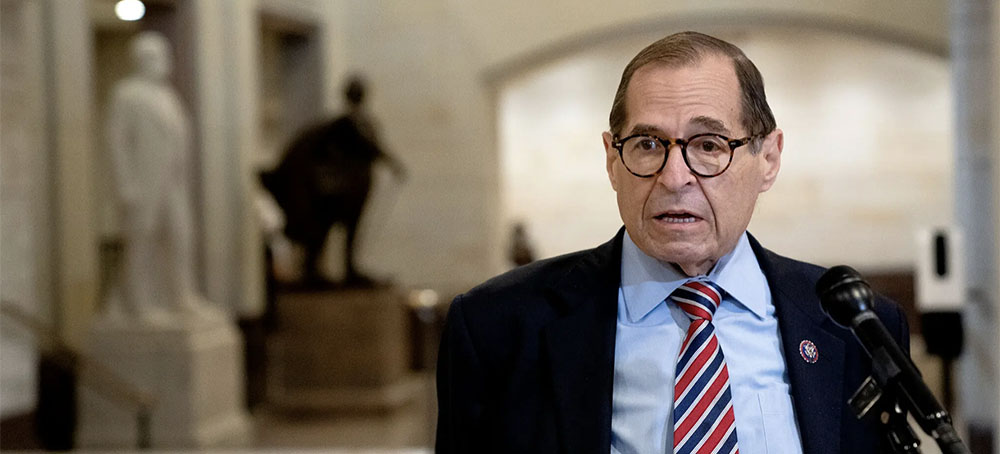 Some joked that the district of Representative Jerrold Nadler, above, had been 'Jerrymandered' to benefit Democrats. (photo: Stefani Reynolds/NYT)
Some joked that the district of Representative Jerrold Nadler, above, had been 'Jerrymandered' to benefit Democrats. (photo: Stefani Reynolds/NYT)
Russell Berman | Republicans Discover the Horror of Gerrymandering
Russell Berman, The Atlantic
Berman writes: "The GOP learns what it's like to be on the losing side of a redistricting power grab."
The GOP learns what it’s like to be on the losing side of a redistricting power grab.
The wails of protest began almost immediately after the lopsided votes concluded in the New York legislature earlier this month. Lawmakers in Albany had redrawn the state’s congressional map to create what instantly became perhaps the nation’s most brutal gerrymander. The “most brazen and outrageous attempt at rigging the election,” a party chair cried. “Egregious, unfair, and unconstitutional,” a senior member of Congress proclaimed. “It’s the voters who should be choosing their representatives, not the other way around,” declared another lawmaker who had been targeted for defeat in the reshuffling.
Voters are surely familiar with these complaints; Democrats have been making them—verbatim, in many cases—for years, accusing Republicans of using extreme partisan gerrymandering to tilt elections in their favor and entrench themselves in the majority. This time, however, Republicans were the victims of a supposed power grab, and they were the ones grousing about it.
The Democrats who control New York politics had drawn maps that could essentially wipe out half of the GOP’s eight congressional seats in the state before a single vote is cast. “It is wrong, and it is illegal,” Representative Elise Stefanik, the upstate New Yorker who serves as chair of the House Republican Conference, told me last week. She is supporting a lawsuit that Republicans nationally and in New York have filed against the Democratic-drawn map, alleging that it violates a prohibition in the state’s constitution against partisan gerrymandering.
Although the new districts could indeed be ruled illegal under New York law, they are not illegal under federal law. That’s because Stefanik and her party have opposed Democratic proposals to ban the practice nationwide. From a purely political standpoint, the GOP’s recent resistance is understandable: Thanks to its dominance of state legislatures and governorships after the 2010 Republican-wave election, it benefited more from gerrymandering than Democrats in the previous round of redistricting.
Heading into the once-a-decade reapportionment process, Democrats and political forecasters warned that Republicans could capture the House majority—now held by Democrats with a mere five-seat margin—through gains won by gerrymandering alone. Yet with maps completed for more than two-thirds of the nation’s 435 House seats, the biggest surprise has been how well Democrats have done. They have fought Republicans at least to a draw and, according to one prominent forecaster, David Wasserman of the Cook Political Report, they might have even gained a few seats overall. “It’s just going to be another election cycle when the prognosticators are wrong,” Stefanik said. (She neglected to mention that those same shaky prognosticators still predict Republicans will take back the House.) Former President Donald Trump offered his own assessment of the national landscape, complaining in a statement that “Republicans are getting absolutely creamed by all the phony redistricting going on all over the country.”
Democrats have fared better for a number of reasons. Victories in competitive 2018 gubernatorial races gave Democrats veto pens in some states, such as Pennsylvania and Wisconsin, where Republicans control the legislature. Democrats also began laying the groundwork for the redistricting fight years in advance with the formation of groups like the National Democratic Redistricting Committee, launched by former Attorney General Eric Holder with the support of former President Barack Obama. In GOP-controlled states such as Texas and Georgia, Republicans have pursued a more defensive mapmaking strategy, seeking to consolidate their power rather than attempting a maximalist (but riskier) approach of knocking out Democratic seats. State courts have struck down more aggressive GOP gerrymanders in North Carolina and Ohio. A major factor, however, is that despite their anti-gerrymandering rhetoric, Democrats have been at least as ruthless as Republicans in the biggest states where they have unfettered power to draw new districts. In Illinois, Democrats approved a map that will likely wipe out two of the GOP’s five current congressional seats. Their haul could be twice as big in New York.
Democrats controlled the mapping process in New York for the first time since before World War II, and they engineered the deadlock of a bipartisan redistricting commission to ensure that they could maximize their advantage. The result was a map that contains many of the hallmarks of a classic gerrymander. Democrats packed more Republicans into Stefanik’s rural upstate district and split a large Army base on the Canadian border, Fort Drum, into two districts. Farther south, they combined the most conservative part of New York City, Staten Island, in a single district with perhaps its most liberal community, Park Slope, in an obvious attempt to oust the city’s lone Republican member of Congress, Representative Nicole Malliotakis. The district now belonging to Representative Jerry Nadler—quickly dubbed the “Jerrymander”—slices down the west side of Manhattan, takes a ferry ride across the East River, cuts a horseshoe-shaped path through a half-dozen neighborhoods on its way to Prospect Park, then wraps around a cemetery containing the earthly remains of Boss Tweed and Horace Greeley before swallowing a huge section of central and south Brooklyn.
One might think that the taste of victimhood might cause Republicans to reconsider the nationwide truce that Democrats have offered on gerrymandering. Not so much. “This is an inherently political process, and it always has been,” former Representative John Faso of New York, who now works with the National Republican Redistricting Trust, told me. “It’s just the Democrats are ultimate hypocrites about it because they want to be pure when it’s the Republicans drawing lines, but they’re very quiet about their own impurity when they are drawing the lines.”
Stefanik told me the federal government “should not oversee elections.” The fourth-term lawmaker has become a rising Republican star, having recruited a new generation of winning GOP women candidates before deposing Representative Liz Cheney to secure a place in the party’s House leadership. But when I asked her whether she would also condemn the gerrymandered maps that Republicans have proposed in states such as Ohio, North Carolina, and Florida, Stefanik swiftly shed her national profile. “I’m speaking out specifically on New York’s gerrymandered maps,” she replied. “I’m a resident of the state of New York. I’m speaking as a citizen, not just as an elected official, but as a citizen about how these maps do not abide by the New York state constitution. And if you want to talk about hypocrisy, get on the phone with any Democrat member of the New York delegation who has railed against gerrymandering.”
Democrats have indeed been quiet about New York’s map, observing the unspoken rule that gerrymandering is to be discussed only by its victims, never by its perpetrators. Holder last week convened a virtual press conference to tout his group’s success in securing fairer maps and challenging Republican attempts to gerrymander in the states they control. He offered a mild defense of New York’s district lines, saying that Democrats had followed census data and noting that even the maps proposed by Republicans on its redistricting commission would have resulted in Democratic gains. Yet in a state where Joe Biden won just over 60 percent of the vote in 2020, Democrats have enacted a map that likely will give their party 85 percent of its House seats. Was Holder contending that New York’s map did not represent a partisan gerrymander? I asked him. He gave a long answer that studiously avoided any use of the G-word. “New York is a decidedly blue state,” he said. “There might have been things I would have done differently, but that map is far more defensible than what Republicans did in Texas, than what they tried to do in North Carolina, what they tried to do in Georgia.”
The real losers of this year’s gerrymandering arms race might be the voters themselves. In their zeal to protect and expand their political turf, both parties have slashed the number of competitive districts across the country, meaning that millions fewer Americans will have a meaningful say in who represents them in Congress. Even Holder lamented the lack of competition in the map Democrats drew in New York. Yet for Democrats, the broader goal of their redistricting effort was not competitive maps but a fair fight for the House, and in the end, the key to achieving some level of parity with Republicans was not less gerrymandering, but more of it.
READ MORE
 A makeshift memorial with crosses for the victims of the Sandy Hook Elementary School shooting massacre stands outside a home in Newtown, Conn., on Dec. 14, 2013. (photo: Robert F. Bukaty/AP)
A makeshift memorial with crosses for the victims of the Sandy Hook Elementary School shooting massacre stands outside a home in Newtown, Conn., on Dec. 14, 2013. (photo: Robert F. Bukaty/AP)
A Gun Manufacturer Is Finally Paying for a Mass Shooting in the United States
William Vaillancourt, Rolling Stone
Vaillancourt writes: "Remington on Tuesday reached a $73 million settlement with families of victims of the 2012 massacre at Sandy Hook Elementary."
Remington on Tuesday reached a $73 million settlement with families of victims of the 2012 massacre at Sandy Hook Elementary
Remington, the maker of the rifle used in the Sandy Hook Elementary School shooting, has reached a historic $73 million settlement with relatives of victims of the 2012 massacre, which left 20 children and 6 adults dead. The settlement marks the first time a gun manufacturer has been held accountable for a mass shooting in the United States.
The families’ lawsuit alleged that the gun manufacturer irresponsibly marketed the Bushmaster AR-15-style rifle to at-risk young men like the school shooter through video games. The $73 million settlement comes less than a year after attorneys for Remington offered the families nearly $33 million to settle. Josh Koskoff, who represents the families, commented then that the company’s insurers “deserve credit for now realizing that promoting the use of AR-15s as weapons of war to civilians is indefensible.”
Koskoff seemed pleased with the settlement on Tuesday. “These nine families have shared a single goal from the very beginning: to do whatever they could to help prevent the next Sandy Hook,” he said in a statement, according to The New York Times. “It is hard to imagine an outcome that better accomplishes that goal.”
The families of five of the children and four of the adults killed in the shooting filed the lawsuit against Remington in 2014. The case reached the Connecticut state Supreme Court in 2019 after Remington argued that it couldn’t be held liable for crimes in which its guns were used, citing the 2005 Protection of Lawful Commerce in Arms Act (PLCAA). “The perception for the gun industry is: ‘We can’t get sued,’” Koskoff told Rolling Stone in 2016. “‘We can be as unethical and as wild and aggressive in the marketing as we want.’”
But in a 4-3 ruling, the court sided with the families, noting that the PLCAA does not exempt “wholly irresponsible conduct such as the wrongful advertising of potentially dangerous products for criminal or illegal purposes.” Remington had marketed the weapons in question as totems of manliness and, as the lawsuit claimed, the company “knowingly marketed, advertised, and promoted the XM15-E2S for civilians to use to carry out offensive, military style combat missions against their perceived enemies.”
Remington filed for bankruptcy in 2018 after years of lackluster sales and legal and public pressure resulting from the massacre. Four of the company’s insurers took over the company’s defense. The bankrupted gun manufacturer last September tried to obtain the school records of each of the victims, drawing immediate criticism from Koskoff. “The records cannot possibly excuse Remington’s egregious marketing conduct, or be of any assistance in estimating the catastrophic damages in this case,” he said, according to The Connecticut Post. “The only relevant part of their attendance records is that they were at their desks on December 14, 2012.”
Twenty-six people were killed in the Dec. 14, 2012 massacre. Twenty of them were children between the ages of six and seven.
READ MORE
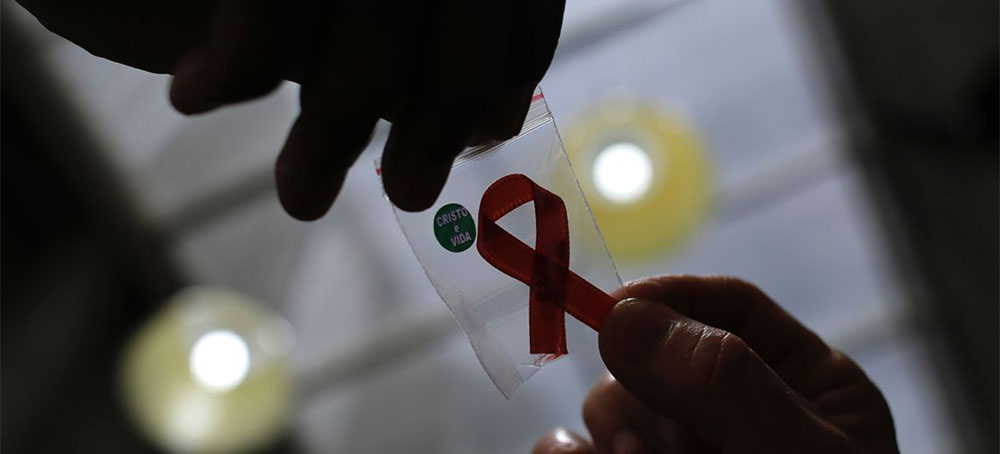 A nurse (L) hands out a red ribbon to a woman, to mark World Aids Day, at the entrance of Emilio Ribas Hospital, in Sao Paulo December 1, 2014. (photo: Nacho Doce/Reuters)
A nurse (L) hands out a red ribbon to a woman, to mark World Aids Day, at the entrance of Emilio Ribas Hospital, in Sao Paulo December 1, 2014. (photo: Nacho Doce/Reuters)
Third Person, First Woman Reported Cured of HIV After Stem Cell Transplant
Julie Steenhuysen, Reuters
Steenhuysen writes: "A U.S. patient with leukemia has become the first woman and the third person to date to be cured of HIV after receiving a stem cell transplant from a donor who was naturally resistant to the virus that causes AIDS, researchers reported on Tuesday."
A U.S. patient with leukemia has become the first woman and the third person to date to be cured of HIV after receiving a stem cell transplant from a donor who was naturally resistant to the virus that causes AIDS, researchers reported on Tuesday.
The case of a middle-aged woman of mixed race, presented at the Conference on Retroviruses and Opportunisitic Infections in Denver, is also the first involving umbilical cord blood, a newer approach that may make the treatment available to more people.
Since receiving the cord blood to treat her acute myeloid leukemia - a cancer that starts in blood-forming cells in the bone marrow - the woman has been in remission and free of the virus for 14 months, without the need for potent HIV treatments known as antiretroviral therapy.
The two prior cases occurred in males - one white and one Latino - who had received adult stem cells, which are more frequently used in bone marrow transplants.
"This is now the third report of a cure in this setting, and the first in a woman living with HIV," Sharon Lewin, President-Elect of the International AIDS Society, said in a statement.
The case is part of a larger U.S.-backed study led by Dr. Yvonne Bryson of the University of California Los Angeles (UCLA), and Dr. Deborah Persaud of Johns Hopkins University in Baltimore. It aims to follow 25 people with HIV who undergo a transplant with stem cells taken from umbilical cord blood for the treatment of cancer and other serious conditions.
Patients in the trial first undergo chemotherapy to kill off the cancerous immune cells. Doctors then transplant stem cells from individuals with a specific genetic mutation in which they lack receptors used by the virus to infect cells.
Scientists believe these individuals then develop an immune system resistant to HIV.
Lewin said bone marrow transplants are not a viable strategy to cure most people living with HIV. But the report "confirms that a cure for HIV is possible and further strengthens using gene therapy as a viable strategy for an HIV cure," she said.
The study suggests that an important element to the success is the transplantation of HIV-resistant cells. Previously, scientists believed that a common stem cell transplant side effect called graft-versus-host disease, in which the donor immune system attacks the recipient’s immune system, played a role in a possible cure.
"Taken together, these three cases of a cure post stem cell transplant all help in teasing out the various components of the transplant that were absolutely key to a cure," Lewin said.
READ MORE
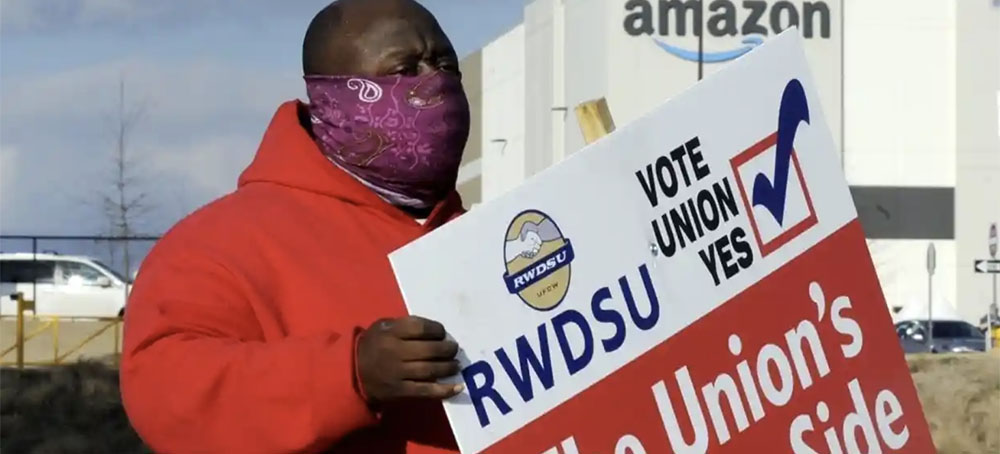 Michael Foster of the Retail, Wholesale and Department Store Union outside the Bessemer Amazon warehouse last week. (photo: Jay Reeves/AP)
Michael Foster of the Retail, Wholesale and Department Store Union outside the Bessemer Amazon warehouse last week. (photo: Jay Reeves/AP)
US Amazon Warehouse Workers Prepare for Historic Union Vote
Michael Sainato, Guardian UK
Sainato writes: "Workers at the Amazon warehouse in Bessemer, Alabama, have begun the rerun of a historic union election after the US labor regulator ruled Amazon's conduct had interfered with a previous election in 2021 and ordered a new vote."
Labor board overturned first election over company’s unfair conduct, giving workers another chance to be the first Amazon facility in US to unionize
Workers at the Amazon warehouse in Bessemer, Alabama, have begun the rerun of a historic union election after the US labor regulator ruled Amazon’s conduct had interfered with a previous election in 2021 and ordered a new vote.
The union drive comes as other large US employers including Starbucks and Target are fighting off union drives. If successful, the warehouse would be the first Amazon facility to unionize in the US. Employees said that Amazon – which now employs more than 1 million people in the US – is fighting hard to make sure this vote also fails, but some are feeling more confident the second time around.
Darryl Richardson, an employee at the Amazon warehouse in Bessemer for two years, said workers and organizers are now more apt to resist Amazon’s union-busting efforts.
“They’re still using the same scare tactics they used last time, but due to the first election, you have employees who understand and know that Amazon isn’t telling them the truth,” said Richardson. “I feel better this time than I did the first time. Employees have been voicing their opinions and standing strong this election.”
More than 6,100 workers are eligible to vote in the union election, which will determine if workers will be represented by the Retail, Wholesale and Department Store Union (RWDSU). Due to high employee turnover, almost half of the eligible workers in this election were not working at Amazon during the first union election.
Ballots were sent to Alabama workers on 4 February, with ballots due to be returned by 25 March. Results will be tallied beginning on 28 March.
Two other Amazon warehouses, JFK8 and LDJ5 in Staten Island, New York, have filed petitions to hold union elections with the National Labor Relations Board (NLRB), though election dates have not been set by the NLRB regional director.
Perry Connelly, 59, who has worked in outbound stowing at the Bessemer warehouse for two years, said that organizing ahead of the first union election started off well, with a majority of workers signing union authorization cards, but that Amazon’s aggressive anti-union campaign and promises of improvements confused or deterred many workers from voting at all or persuaded them to vote against the union.
“We just want Amazon to be held accountable for all the things that make the job, the workplace, unbearable,” said Connelly. “What we do and what we put out, Amazon can pay a lot better and not have such a high rate of turnover of employees. A lot of people come in and they’re not there for six or seven months, they don’t make it that long because of the working conditions.”
Rerun union elections are relatively rare, with unions prevailing in a slim majority of those elections in recent years. But Connelly claimed this time around, there’s more support for the union. He said many workers switched from voting no in the first election to supporting it, because Amazon didn’t fulfill the promises they made during the first election, and the union organizing campaign has expanded to handing out union T-shirts, door-knocking efforts that weren’t possible earlier in the Covid-19 pandemic, and partnering with other local unions and community groups.
Connelly cited issues such as better pay, better promotional opportunities, more respect from management toward workers and less hostility toward productivity rates as a few of the reasons he is supporting the union.
“We’re not asking for a lot. We’re just asking for better conditions and less work hassle. We feel like we’re in a hostile work environment day in and day out,” said Connelly. “Working for Amazon, no one should be worried about paying bills when you work for a multibillionaire, and we just want what we think is fair.”
US businesses have fought hard against union drives in recent years. A 2019 report by the Economic Policy Institute found that 41.5% of employers had violated federal labor law in union election campaigns and employers spend about $340m annually on union avoidance, issues that have driven campaigns for federal labor law reforms to expand workers’ rights and steepen penalties for employers violating labor laws.
As part of the new election ruling, Amazon reached a settlement with the NLRB, agreeing to refrain from threatening workers with discipline or calling the police on workers engaging in union activity outside the warehouse. If Amazon is found to violate the settlement, the NLRB could more easily sue the company.
Amazon is once again aggressively opposing the unionization effort at the warehouse, with regular anti-union meetings where outside consultants and managers are encouraging workers to vote against the union. A worker at the Bessemer warehouse has already filed unfair labor practice charges with the NLRB against Amazon, alleging the settlement was violated because he claims management warned him about speaking with co-workers about the union.
During the first union election, Amazon installed a United States Postal Service mailbox in front of the warehouse, surrounded by signs encouraging workers to vote no in the election. That mailbox was a significant factor in the first union election being overturned by the NLRB. The union has already made a request for review to the NLRB of objectionable conduct over the mailbox, as it remains on site at the warehouse, but was just moved to a different location.
The union argued the mailbox undermined the election as it is subject to constant surveillance by the company, and the stigma surrounding the mailbox as employer-controlled remains. The NLRB ruled the claims would be resolved after the new election.
Contacted by the Guardian, Amazon did not comment on how its conduct this election has changed from the previous one.
A spokesperson said in an email: “Our employees have always had the choice of whether or not to join a union, and they overwhelmingly chose not to join the RWDSU last year. We look forward to our team in BHM1 having their voices heard again.”
READ MORE
 Men look at the car where three Palestinians were killed by Israeli security forces in the occupied West Bank city of Nablus on Feb. 8, 2022. (photo: Nasser Ishtayeh/SOPA Images/LightRocket/Getty Images)
Men look at the car where three Palestinians were killed by Israeli security forces in the occupied West Bank city of Nablus on Feb. 8, 2022. (photo: Nasser Ishtayeh/SOPA Images/LightRocket/Getty Images)
Israel Revives Assassination Tactics Not Seen for 15 Years in the West Bank
Jesse Rosenfeld, Oren Ziv and Ahmad Al-Bazz, The Intercept
Excerpt: "The triple assassination recalled the darkest days of the Second Intifada - and Israel's impunity to commit violence."
The triple assassination recalled the darkest days of the Second Intifada — and Israel’s impunity to commit violence.
Palestinians were shocked last week by a brazen midday Israeli military assault that employed tactics not seen in the West Bank in over 15 years. Human rights advocates said the Israeli killings of three Palestinian men constituted brutal and coordinated assassinations.
The ambush targeted three fighters belonging to the Al-Aqsa Martyrs Brigade, a militant group, who were wanted for allegedly shooting at members of the Israeli army and settlers in recent weeks, though no specifics were offered. The men were driving through Nablus’s winding streets when Israeli security forces in cars with Palestinian license plates shot Ashraf al-Mabsalt, Adham Mabrouka, and Muhammad al-Khalil dead, leaving local residents to deal with the gruesome fallout of the assault.
Israeli security forces claimed that the killings, carried out by the Border Police’s National Counter-Terrorism Unit, known colloquially as Yamam, were intended as an arrest raid and that the officers fired in self-defense. A joint Intercept, Local Call, and +972 Magazine investigation, however, points to a planned assassination in an area under Palestinian Authority control, a widely condemned tactic.
For Shawan Jabarin, the general director of Al-Haq, a West Bank-based Palestinian human rights group, the killings amount to war crimes. Al-Haq — which was recently labeled a terror group by the Israeli government, an attempt, the group says, to halt its probes — collected witness testimonials from the scene of the Nablus shooting.
“It’s an extrajudicial execution,” said Jabarin. He said his group had found no evidence that the Palestinian fighters ever fired or attempted to fire a shot: “The three persons were known by the Israelis, and they came merely to kill them.”
The killings conjured bitter memories of the extrajudicial assassinations that marked the darkest days of the Second Intifada, the Palestinian uprising of 2000 to 2005, and the attendant Israeli reprisals. Across Palestinian society, a level of outrage not seen in recent months spurred a one-day general strike and checkpoint riots across the West Bank.
The families of those killed said the carnage was the horrific realization of threats made against them in recent months by Israel’s internal security service, the Shin Bet.
Raed Al-Khalil, 51, Muhammad Al-Khalil’s father, recalled during his son’s funeral that one Shin Bet officer had called the family over a dozen times, issuing threats that culminated in a promise that Muhammad would be executed.
“The last [call] was two months ago,” said Al-Khalil. “He said they would send the Yamam unit to assassinate my son.” (The Shin Bet did not reply to requests for comment about its phone calls to family members of the fighters.)
Adham Mabrouka’s brother, Ahmad, described a similar experience of escalating threats from the Shin Bet in the runup to the killing. “When I met them face to face,” he said of the Israeli security officers, “they threatened to harm the family and raid [our] house.” By the last of what Ahmad Mabrouka said were at least 11 phone calls, a Shin Bet officer said that Adham would be executed.
“They said if he didn’t hand himself over, it will get to the level of assassination, and mentioned the Yamam unit,” recalled Mabrouka. “I realized he was going to die, but not in that way. He has 35 bullets in his body.”
Evidence on the Scene
A video, witness testimonies, and evidence collected by The Intercept, Local Call, and +972 at the scene all point to an attack by Israeli security forces against the carload of Palestinians.
The video, released Monday, shows a yellow Palestinian taxi on a hillside road cutting off the fighters in their silver Fiat. Another Palestinian-plated van carrying Israeli officers then swings around behind the Fiat to prevent the driver from reversing. A barrage of bullets from the taxi’s direction then destroys the Fiat’s windshield. After about 10 seconds, Israeli security officers exit from the van and from the taxi; some of the officers open fire at the driver’s side of the Fiat as others stand guard behind them.
Both vehicles carrying Israeli security forces came down a hill that intersected with the road where the attack was launched.
On the scene, bullet holes pockmarking the apartment building doors on the far side of the road and signposts down the street all appeared to come from the Israeli positions — the locations of the Israelis’ vehicles and where the officers stood around them. There are no apparent bullet holes or fragments next to or behind the Border Police officers’ locations in the video and no shell casings from around where the Fiat had been — indicating that the Israeli officers were not fired upon.
A spokesperson for Israel’s Border Police confirmed that no shots were ever fired toward Israeli forces but said that the Palestinians “were armed with loaded guns and about to open fire.”
According to two witnesses who declined to be identified due to fear of reprisal, it all started with a long burst of steady and consistent gunfire.
“I returned home from work. I heard gunshots. Not one or two separate [shots],” said a man who lives by the scene of the attack. He described a strong and continuous blast of automatic gunfire: “I told my wife and my children not to go out and do not come near the windows.”
A woman whose apartment overlooks the scene of the killing said, “I heard the shots and went to the window to see what happened. I was very frightened. The car was riddled with bullets.”
The testimonies collected by Al-Haq include one from an eyewitness who saw the assault from beginning to end. The account corroborates what appears to be happening in the video: They describe Israeli officers opening fire on the Fiat from the taxi’s open door before even leaving the vehicle. The Israeli officers then got out and kept firing live rounds at the car in a second blast of gunfire. While the 92-second video stops before the officers approach the Fiat, Al-Haq’s witnesses said the Israelis then opened the door and shot inside to “confirm” the kills.
Orders to Kill
The assertion by Palestinians that the killings were planned assassinations was corroborated by Ilan Paz, a former head of the Civil Administration, the arm of the Israeli military that governs the 2.8 million Palestinians living in the West Bank.
Paz said he believes that the clear goal of the operation was to kill the three Palestinians. “I do not think they told [the Yamam officers] to arrest them, and if things get dicey, they would be assassinated instead,” Paz told The Intercept, Local Call, and +972. “My assumption is they planned for an assassination.”
According to Paz, targeted assassinations must receive approval from highest echelons of the security establishment, including the defense minister. (Defense Minister Benny Gantz’s office did not respond to a request for comment.)
Paz said, however, that it is unclear whether the security forces are officially reinstating extrajudicial killings as a policy in the West Bank. He does not think the Nablus killing arose from “a strategic decision of going in new, more aggressive directions. He said, of the assassination, “That does not necessarily mean that there is a new policy — it is an assessment of risks and opportunities.”
During the Second Intifada, when Palestinians launched an armed uprising against the occupation, Israeli security forces regularly carried out assassinations throughout the West Bank and Gaza. The so-called targeted killings have continued in the Gaza Strip, against fighters from the Palestinian militant groups Hamas and Islamic Jihad, but Israel refrained from such overt attacks in the West Bank. Groups aligned with Fatah, the secular Palestinian movement that rules the West Bank, have in particular been spared, including the Al-Aqsa Martyrs Brigade, which Israel considers a terrorist organization.
The Palestinian Authority, under Fatah leader President Mahmoud Abbas, reestablished its security relationship with Israel at the end of the Second Intifada — an arrangement in which Palestinian security forces tackle potential threats to Israel. Palestinian security forces only have jurisdiction over Palestinians and are required to return to the barracks when Israel carries out incursions in their territory.
For Hanan Ashrawi, a former Palestinian Authority Cabinet minister and a member of the Palestine Liberation Organization’s Executive Committee, attacks like the one in Nablus are designed to flaunt Israeli impunity.
“They assume they can be judge, jury, and executioner,” she said. “They are creating another a situation of instability and anger, but also anger at the [Palestinian] leadership that thinks security coordination must proceed while Israel continues to shoot and kill Palestinians at will.”
Hours later, under pressure, Abbas declared an end to Israeli-Palestinian Authority security coordination — a move that has been announced multiple times over the last several years but never acted on. According an officer in the Palestinian security forces, who requested anonymity because they were not authorized to speak and feared reprisal, there was no subsequent order to stop the coordination, despite the president’s statement. The official, with a chuckle, said, “It was just another statement by politicians.”
READ MORE
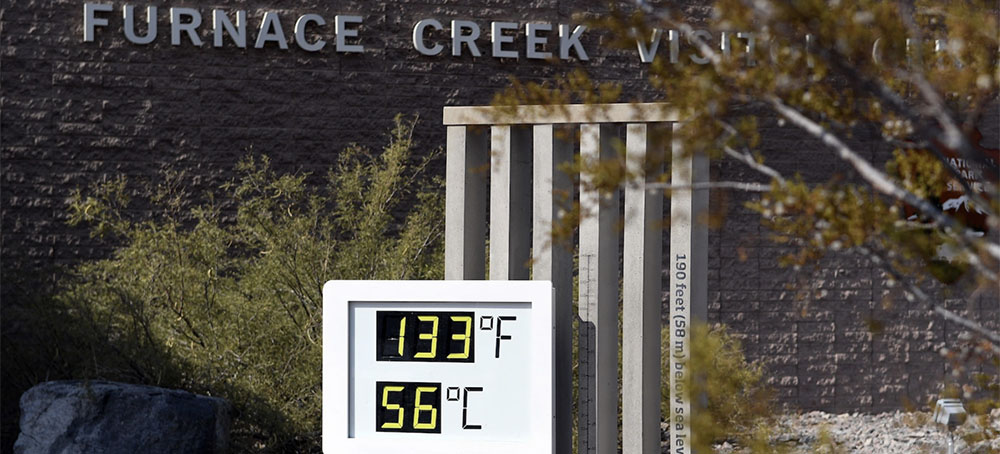 Extremely high temperatures. (photo: David Becker/Getty Images)
Extremely high temperatures. (photo: David Becker/Getty Images)
A Third of Americans Are Already Facing Above-Average Warming
Oliver Milman, Grist
Milman writes: "Temperatures in 499 counties across West, Northeast, and upper Midwest US have already breached 2.7 degrees Fahrenheit."
Temperatures in 499 counties across West, Northeast, and upper Midwest US have already breached 2.7 degrees Fahrenheit.
More than a third of the American population is currently experiencing rapid, above-average rates of temperature increase, with 499 counties already breaching 2.7 degrees Fahrenheit of heating, a Guardian review of climate data shows.
The United States as a whole has heated up over the past century due to the release of planet-warming gasses from burning fossil fuels, and swaths of the U.S. West, Northeast, and upper Midwest – representing more than 124.6 million people – have recorded soaring increases since federal government temperature records began in 1895.
Though the climate crisis is convulsing the U.S., it is doing so unevenly. Hotspots of extreme warming have emerged in many of America’s largest cities, and places as diverse as California’s balmy coast to the previously frigid northern reaches of Minnesota, while other places, particularly in the South, have barely seen their temperatures budge.
“The warming isn’t distributed evenly,” said Brian Brettschneider, an Alaska-based climate scientist who collated the county temperature data from the National Oceanic and Atmospheric Administration (NOAA). “Many places have seen dramatic changes, but there are always some places below the average who will think, ‘It didn’t seem that warm to me.’ The impacts differ depending where you are.”
Ventura county in California has heated up more than any other county in the contiguous U.S., according to the NOAA data, experiencing a 4.75 degrees F increase in total warming in the period from 1895 to 2021. Meanwhile, counties that include many of America’s largest cities, including New York, Los Angeles, Miami, Philadelphia, San Francisco, and Boston, have all seen their average temperatures rise far beyond the national average, which stands at about a 1.8 degrees F increase on pre-industrial times.
Mark Jackson, a meteorologist at the National Weather Service based in Oxnard in Ventura county said the county’s temperature increase was “a remarkable number, it’s a scary number when you consider the pace we are looking at.” Jackson said the county had seen a large increase in heatwaves, including a spell above 100 degrees F last summer that “really stressed” the local community.
Ventura county, which hugs the Californian coast north-west of Los Angeles, is known for a pleasant Mediterranean climate cooled slightly by the proximity of the ocean. But Jackson said that recent heatwaves have seen warm air flow down from mountains in the nearby Los Padres national forest to the coast, while the ocean itself is being roiled by escalating temperatures. “It’s been really remarkable to see it get that hot right up to the coast,” he said.
California is in the grip of its most severe drought in 1,200 years and scientists say this is fueling the heat seen in many places in the state – Los Angeles has warmed by 4.2 degrees F since 1895, while Santa Barbara has jumped by 4.38 degrees F – by reducing moisture in soils, which then bake more quickly.
Higher temperatures are also worsening the risk of wildfires in the state. “We lost everything,” said Tyler Suchman, founder of online marketing firm Tribal Core who in 2017 fled with his wife to escape a huge wildfire that razed their home in Ojai, in Ventura county. “It was harrowing. The winds were blowing like crazy and the hills lining the highway were all on fire, I had never seen anything like it.”
Just 11 months later, a separate wildfire destroyed the couple’s next home, in Malibu, as their neighbor scooped up water from his hot tub in a desperate attempt to tackle the flames. “No one wants us to move next to them now,” Suchman said. “You can see how the area has changed over the 18 years since we moved to Ojai. It’s a beautiful place but regrettably we can’t live there now, the risk is too great.”
Hotspots of above-average warming are found across the U.S. Grand county in Utah, a place of sprawling deserts, cliffs, and plateaus, is the second fastest warming county in the lower 48 states, while every county in New Jersey, Massachusetts, and Connecticut has warmed by more than 2.7 degrees F since 1895.
It’s the more northern latitudes that have experienced the most extreme recent heat, however, with counties in Alaska making up all of the top six fastest warming places since 1970 (comparable temperature data for Alaska does not go back further than the 1920s). Alaska’s North slope, situated within the rapidly warming Arctic, has heated up by an enormous 6.6 degrees F in just the past 50 years.
“There really is a climate shift under way in Alaska, everyone can see things are different than they used to be and everyone is concerned about what the future here will look like,” said Brettschneider, who added that even his teenage children had noticed the retreat of sea ice, an elongating fire season and a dearth of cold days.
The warmth is also melting frozen soils, known as permafrost, causing buildings to subside and roads to buckle. “If you drive on the roads near Fairbanks you better have a strong stomach because it feels like you’re riding a rollercoaster,” said Katharine Hayhoe, a climate scientist at Texas Tech University and chief scientist at the Nature Conservancy.
Other locations traditionally used to severe cold have also seen sharp temperature increases. Roseau and Kittson counties, in northern Minnesota, are both in the top five fastest warming counties in the lower 48 states, with their warming driven by winters that have heated up by around 7 degrees F in the state since modern record keeping began.
Winters are warming more quickly than summers because more heat usually escapes the land during the colder months, but it is now being trapped by greenhouse gases. “Some might say ‘well I like warmer winters’ but people are noticing negative impacts, such as changes to the growing season and the loss of cultural practices such as cross-country skiing races,” said Heidi Roop, a climate scientist at the University of Minnesota. “Even small temperature changes have big consequences.”
Globally, governments set a goal in the 2015 Paris climate agreement to avoid a temperature rise of 2.7 degrees F above the pre-industrial era. Beyond this point, scientists say, the world will face increasingly punishing heatwaves, storms, flooding, and societal unrest.
While certain areas of the U.S. have already passed 2.7 degrees F, the important metric is still the global average, Hayhoe said. “In some places a 3.6 degrees F increase is fine but 4.5 degrees F is when the wheels fall off the bus, some locations are OK with 5 feet of sea level rise because of their elevation while others can’t cope with 5 inches because they are low-lying,” she said. “Local vulnerability is very customized. What’s relevant for communities is whether the world meets its targets or not, it’s a collective target for the world.”
That global threshold is in severe peril, with some forecasts warning that 2.7 degrees F could be breached within a decade without drastic cuts to carbon emissions. Communities will need to brace themselves for the consequences of this, according to Roop.
“The warming we are seeing is pushing at the bounds of lived human experience, of what we thought was possible,” she said. “We are paying the costs for that and we need to prepare for the changes already set in motion, as well as to prevent further warming.”
READ MORE
Contribute to RSN
Follow us on facebook and twitter!
Update My Monthly Donation
PO Box 2043 / Citrus Heights, CA 95611
![View of Aunt Betty's Pond in Hyannis looking southeast towards Main Street in Hyannis and the harbor in October 2021. PFAS has been detected in the pond's water. [Steve Heaslip/Cape Cod Times file]](https://www.gannett-cdn.com/presto/2021/10/01/NCCT/849c30c5-9bef-4ec7-bca8-bca4dc6c8f20-100121sh03.jpg?width=660&height=355&fit=crop&format=pjpg&auto=webp)



